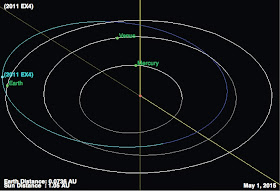Asteroid 2011 EX4 passed by the Earth at a distance of 11 000 000 km (28.6 times the average distance between the Earth and the Moon, or 7.35% of the average distance between the Earth and the Sun), slightly after 1.20 am GMT on Thursday 30 April 2015. There was no danger of the asteroid hitting us, though had it done so it would have presented only a minor threat. 2011 EX4 has an estimated equivalent diameter of 23-71 m (i.e. it is estimated that a spherical object with the same volume would be 23-71 m in diameter), and an object of this size would be expected to explode in an airburst (an explosion caused by superheating from friction with the Earth's atmosphere, which is greater than that caused by simply falling, due to the orbital momentum of the asteroid) in the atmosphere between 20 and 3 km above the ground, with only fragmentary material reaching the Earth's surface, although since an object at the upper end of this range would be expected to release an amount of energy equivalent to about 16 megatons of TNT (roughly 940 times the energy released by the Hiroshima bomb), then being directly underneath it might be fairly unpleasant.
The calculated orbit of 2011 EX4. JPL Small Body Database.
2011 EX4 was discovered on 2 March 2011 by the Massachusetts Institute of Technology's Lincoln Near Earth Asteroid Research Laboratory in Socorro, New Mexico. The designation 2011 EX4 implies that it was the 123rd asteroid (asteroid E4) discovered in the first half of March 2011 (period 2011 E).
2011 EX4 has a 289 day orbital period, with an elliptical orbit tilted at an angle of 3° to the plain of the Solar System which takes in to 0.62 AU from the Sun (62% of the distance at which the Earth orbits the Sun, considerably inside the orbit of Venus) and out to 1.09 AU (9% further away from the Sun than the Earth). This means that close encounters between the asteroid and Earth are fairly common, with the last thought to have happened in December 2014 and the next predicted in November 2018. Although it does cross the Earth's orbit and is briefly further from the Sun on each cycle, 2011 EX4 spends most of its time closer to the Sun than we are, and is therefore classified as an Aten Group Asteroid. This also means that close encounters between 2011 EX4 and Venus are quite common, with the last having occurred in April 2013 and the next predicted for November 2018.
See also...
The Eta Aquarid Meteor Shower will be at a peak on Tuesday 5/Wednesday 6 May 2014, with up to 45 meteors per hour at it's peak, radiating from the constellation of Aquarius. This does not spend...
Asteroid 2015 HC1 passed by the Earth at a distance of 8 407 100 km (21.9 times the average distance between the Earth and the Moon, or 5.62% of the average distance between the Earth and the Sun), slightly after 10.15 pm GMT on Wednesday 29 April 2015...
Asteroid 2015 HT10 passed by the Earth at a distance of 627 100 km (1.63 times the average distance between the Earth and the Moon, or 0.42% of the average distance between the Earth and the Sun), at about 4.55 am GMT on Wednesday 29 April...
Follow Sciency Thoughts on Facebook.




